The Calla Lily, known scientifically as Zantedeschia, stands out as a timeless selection for wedding florals, renowned for their elegant, trumpet-shaped petals. These flowers, available in a spectrum of hues from pristine white to vibrant red, not only enhance the aesthetic appeal of bridal arrangements but also carry profound symbolic meanings such as rebirth and majesty. As we explore the various facets of this sophisticated bloom—from its physical characteristics to its cultural significance—one can appreciate why it remains a favored choice for couples seeking to infuse their nuptials with both beauty and meaning.
Flower Overview
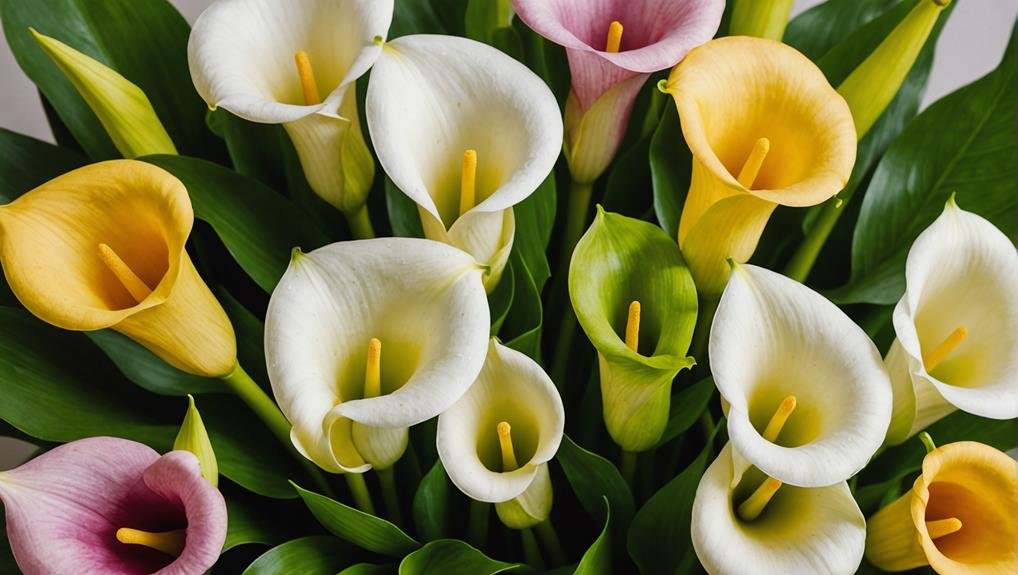
Zantedeschia, commonly known as the Calla Lily, is a herbaceous perennial renowned for its tubular-shaped flowers and elegant foliage. This plant has become a staple in wedding floral arrangements due to its striking appearance and symbolic meanings.
Calla Lilies are often featured in wedding lily bouquets, thanks to their chalice-shaped flowers that exude sophistication and grace. These blooms come in a variety of colors, offering versatility for matching different wedding themes and palettes.
Calla Lilies are particularly favored for their association with purity and rebirth, making them a meaningful addition to any wedding ceremony. As a symbol of rebirth, they are often included in bridal bouquets and centerpieces, adding a touch of sentimentality to the occasion. Their tall stems and solid green or speckled leaves contribute to the overall elegance of floral arrangements, enhancing the aesthetic appeal of the event.
Moreover, Calla Lilies are practical for wedding use due to their longevity. They typically bloom about eight weeks after planting and can last for a couple of months, ensuring they remain vibrant and fresh throughout the celebration. This durability makes them an ideal choice for brides seeking both beauty and resilience in their wedding flowers.
Physical Description
The Calla Lily's distinctive physical characteristics, including its trumpet-shaped blooms and variety of colors such as white, yellow, pink, and red, greatly contribute to its popularity in wedding floral arrangements. These elegant flowers, also known as Arum Lilies, are celebrated for their striking simplicity and timeless beauty.
The smooth, curved petals of the Calla Lily form a sleek, funnel-like shape, often compared to a trumpet, which adds an element of sophistication to any bouquet or decorative piece. Originating from the Victorian era, Calla Lilies have long been admired for their symbolism and aesthetic appeal.
The flowers signify rebirth, resurrection, majesty, and beauty, making them an ideal choice for weddings, where they can embody the new beginnings and the grandeur of the occasion. Their versatility is another key feature; Calla Lilies can be used effectively in a range of floral arrangements, including bridal bouquets, boutonnieres, corsages, and decor elements.
The robust nature of Calla Lilies guarantees they are long-lasting, maintaining their pristine appearance throughout the wedding day. Their ability to complement various styles and themes, from classic to contemporary, further solidifies their status as a wedding favorite.
Available Colour Varieties
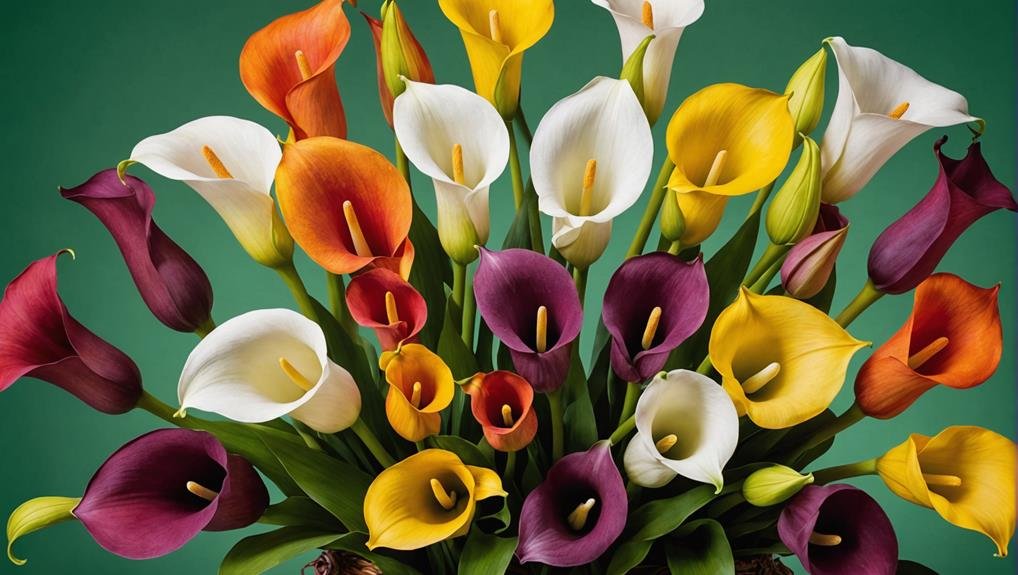
Calla lilies come in an extensive palette, ranging from the purest whites to deep, dramatic blacks, offering unparalleled versatility for wedding floral arrangements. These elegant blooms are available in a wide array of colors, including vibrant yellows, oranges, pinks, reds, purples, and greens. The diverse color varieties of calla lilies make them an ideal choice for creating stunning wedding bouquets and centerpieces that can be tailored to any wedding theme.
The availability of multiple color options allows for significant creativity and customization in floral arrangements. Brides can select calla lilies in hues that perfectly align with their wedding theme and color scheme. This flexibility ensures that the floral decor complements the overall aesthetic of the event, adding a sophisticated touch.
To highlight the versatility of calla lilies in weddings, consider the following:
- Monochromatic Elegance: Use a single color variety to create a cohesive, elegant look.
- Bold Contrasts: Combine different color varieties to add depth and visual interest.
- Seasonal Themes: Choose colors that reflect the season, such as pastels for spring or rich tones for autumn.
Incorporating calla lilies into wedding floral arrangements offers endless possibilities, guaranteeing each celebration is as unique and memorable as the couple themselves.
Latin Name and Taxonomy
Understanding the Latin name and taxonomy of the calla lily provides valuable insight into its botanical origins and classification. The calla lily, known scientifically as Zantedeschia, belongs to the family Araceae. This genus encompasses several species and hybrids, each distinguished by their elegant, trumpet-shaped flowers. Commonly referred to as Arum Lilies, Zantedeschia plants are notable for their distinctive and sophisticated appearance, making them a popular choice for weddings and other formal events.
The taxonomy of Zantedeschia highlights its unique botanical characteristics and evolutionary history. The genus Zantedeschia is comprised of various species, which are often categorized by their striking floral structures and vibrant color palettes. The classification within this genus reflects the diversity and adaptability of these plants, which thrive in varied environmental conditions.
Below is a table summarizing key details about the taxonomy of Zantedeschia:
| Attribute | Detail |
|---|---|
| Latin Name | Zantedeschia |
| Common Name | Calla Lily, Arum Lilies |
| Family | Araceae |
| Genus | Zantedeschia |
| Flower Structure | Elegant, trumpet-shaped |
| Notable Traits | Diverse species and hybrids |
This understanding of the genus and taxonomy of calla lilies provides a foundation for appreciating their botanical elegance and versatility.
Geographical Origins
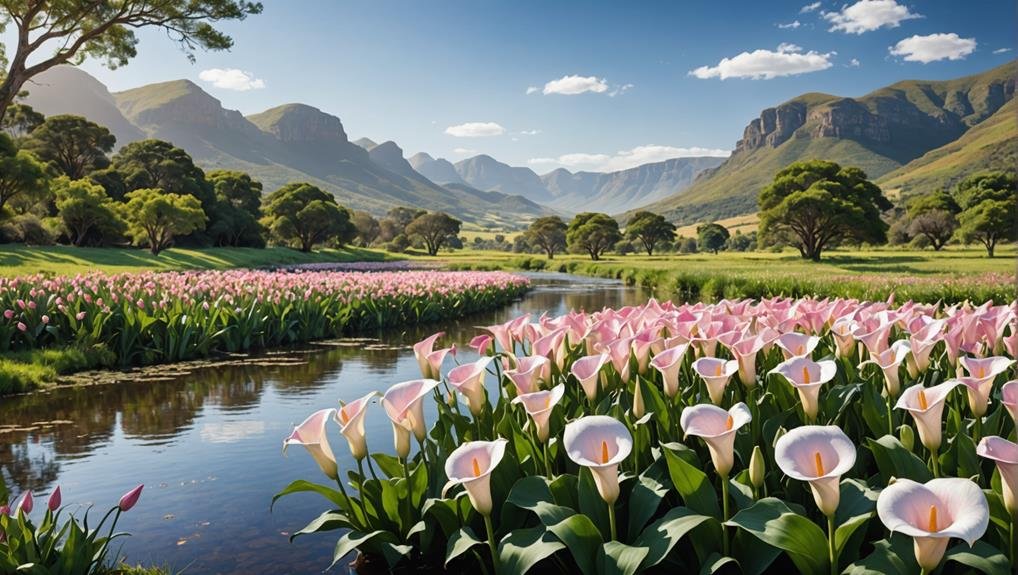
Native to the warm climates of southern Africa, Zantedeschia plants flourish in regions that provide the ideal conditions for their growth and development. Calla Lilies, as they are commonly known, originate from the southern parts of Africa, particularly South Africa, where they thrive in the temperate and subtropical environments.
Understanding the geographical origins of these plants is important for appreciating their unique characteristics and cultivation requirements.
Zantedeschia's native habitat offers several advantages that contribute to their success as perennial plants. Here are three key aspects of their geographical origins:
- Climate: The warm, frost-free climates of South Africa offer the perfect conditions for Calla Lilies to thrive, with temperatures that support year-round growth.
- Soil: The well-drained, organically rich soils found in their native regions allow Zantedeschia to develop strong root systems and produce their iconic trumpet-shaped blooms.
- Rainfall: The seasonal rainfall patterns in South Africa ensure that these plants receive adequate moisture during their growing periods, which is important for their health and vigor.
Season Availability
Zantedeschia, commonly known as Calla Lilies, are mainly in season from late spring to early fall, making them an ideal choice for summer weddings. During this period, their peak availability guarantees a wide selection of colors and varieties, enhancing the aesthetic appeal of wedding flowers. Their vibrant hues and elegant form make Calla Lilies a favorite among brides and event planners.
To help visualize their seasonality, consider the following table:
| Season | Months (Northern Hemisphere) | Availability | Peak Season |
|---|---|---|---|
| Late Spring | May – June | High | Begins |
| Early Summer | June – July | Very High | Peak |
| Mid Summer | July – August | Very High | Peak |
| Early Fall | September – October | Moderate | Ends |
Calla Lilies can be sourced from florists, flower markets, and online suppliers. It's important to note that the availability of specific colors and varieties may vary depending on the region and supplier. Proper planning and advance orders are essential to secure the desired flowers for the wedding day. Their reliable availability in the summer months makes them a practical and stunning choice for wedding flower arrangements.
Growing Conditions
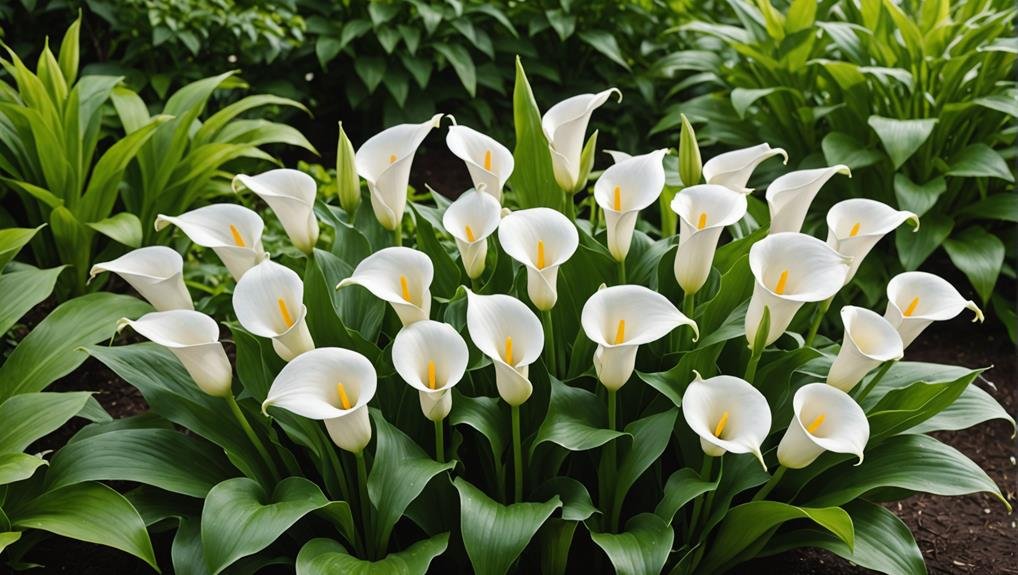
For the best growth, calla lilies need a balance of full sun to partial shade and well-drained, moist soil. These elegant flowers thrive in humid conditions and are ideally suited to temperatures between 60 to 80 degrees Fahrenheit.
Maintaining optimal growing conditions is vital for their development and bloom quality.
When planting calla lily rhizomes, follow these guidelines:
- Depth and Soil: Plant rhizomes 3 to 4 inches deep in porous soil. Hybrids perform best in high-quality potting mix for containers or sandy soil enriched with fertilizer when planted in the ground.
- Watering: Water calla lilies when the soil is slightly dry. Overwatering can lead to root rot, so it's crucial to maintain a balance.
- Sun Exposure: Calla lilies grow well in areas with full sun to partial shade. They need enough sunlight to flourish but can also tolerate some shade, especially in hotter climates.
As temperatures drop, it's vital to monitor the growing environment to make sure the lilies continue to thrive.
Cultural Significance
Celebrated for their elegance and profound symbolism, calla lilies hold a significant place in various cultural traditions. Known for their trumpet-shaped blooms, these flowers symbolize rebirth, resurrection, majesty, and beauty. Their association with elegance and sophistication dates back to the Victorian era, where they were cultivated not just for their aesthetic appeal but also for their deep cultural significance.
In many cultures, calla lilies are revered for their symbolic meanings, making them a classic choice for weddings. Each color of the calla lily carries its own unique significance, adding layers of meaning to floral arrangements. For instance, white calla lilies symbolize purity and innocence, while purple ones represent royalty and passion.
The cultural significance of calla lilies enhances their appeal in wedding ceremonies, providing a meaningful touch to the celebration. Their elegance and symbolism resonate deeply, making them more than just decorative elements.
| Color | Symbolism |
|---|---|
| White | Purity, Innocence |
| Purple | Royalty, Passion |
| Yellow | Gratitude |
| Pink | Appreciation, Love |
Typical Use in Weddings
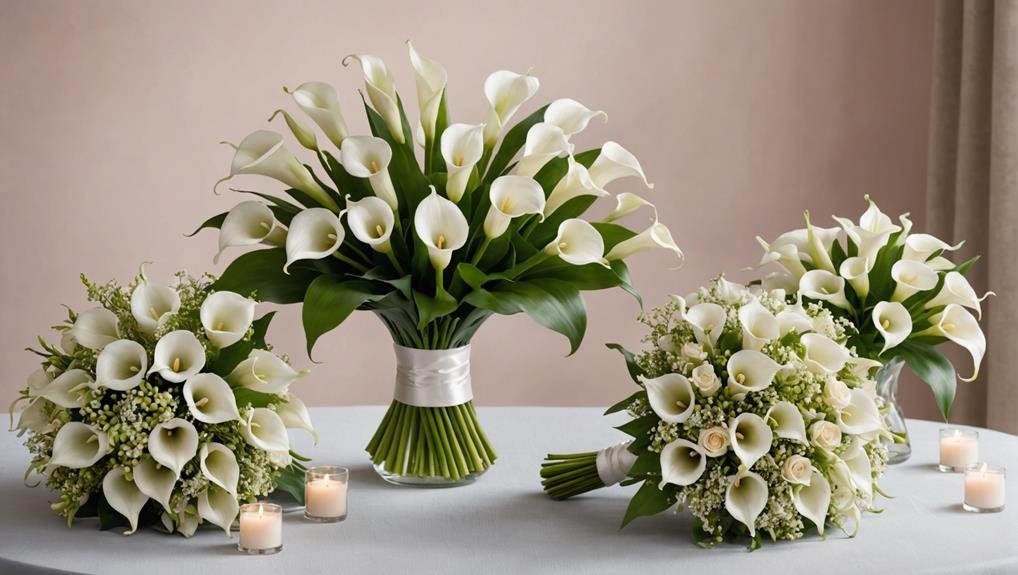
Given their profound symbolism and aesthetic appeal, calla lilies are a quintessential choice for various wedding elements, including bouquets, boutonnieres, corsages, and venue decor. Their elegant form and wide range of colors make them a versatile option for any wedding theme, from classic to contemporary. Popular in bridal bouquets, calla lilies lend an air of sophistication and purity, perfectly complementing the bride's attire.
When planning a wedding, incorporating calla lilies can be both a practical and beautiful choice. Here are three key ways they are typically used:
- Bridal Bouquets: Calla lilies are a popular wedding flower due to their sleek, trumpet-like shape, which adds a touch of grace to bridal bouquets. Their availability in various shades allows for customization to match any color scheme.
- Boutonnieres and Corsages: Their compact size and striking appearance make calla lilies ideal for boutonnieres and corsages, adding elegance without overwhelming the ensemble.
- Venue Decor: Whether used in centerpieces or aisle decorations, calla lilies offer a timeless and sophisticated touch to wedding venues.
For those planning large-scale events, wholesale calla lilies provide an affordable option without compromising on quality, making them a practical choice for stunning wedding arrangements.
Alternative Flower Types
While calla lilies are a popular choice for weddings, exploring alternative flower types can add variety and uniqueness to your arrangements.
Roses, known for their timeless elegance, are a versatile option, available in numerous colors that can suit any wedding theme.
Hydrangeas, with their voluminous and lush blooms, provide a soft, romantic feel, perfect for bouquets and centerpieces.
Peonies, celebrated for their ruffled petals and sweet fragrance, are another excellent choice, especially for spring and early summer weddings.
For those seeking a more vibrant and rustic touch, sunflowers can bring a cheerful and bold statement to wedding decor.
Dahlias, with their intricate and diverse forms, offer a sophisticated and striking appearance that can elevate any floral arrangement. Mixing these flowers with calla lilies can create a dynamic and visually appealing display.
Additionally, incorporating elements like baby's breath, eucalyptus, and succulents can complement the primary flowers, adding texture and depth to the overall design.
Orchids, tulips, and carnations provide further options to diversify your floral selections, ensuring a personalized and stunning wedding floral design.
